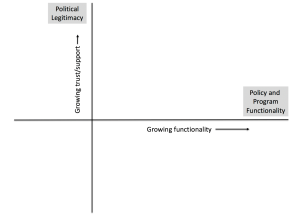written by Matt Andrews
There are many views on what constitutes success and failure in public policy implementation. I have been chewing on these a lot over the last couple of years as I try to make sense of the challenges of implementation and of knowing when implementation is going well or not.
Here are some approaches I find useful in this work.
First, a large literature on project success is relevant in this discussion—because many public policies are implemented through project-like processes (with some studies even referring to the ‘projectization‘ of various policy domains, especially in international development). The project management literature tends to emphasize different types of ‘success’ in the implementation process (if you want to read more detail, I advise this article on the topic by Paul Bannerman):
(i) Process or project management success: the immediate performance of a project against its main design parameters—schedule (time), budget (cost), scope, and quality.
(ii) Product success: the extent to which a project delivered promised ‘products’, and if those products were used and considered useful by intended users (or beneficiaries).
(iii) Business or Strategy (or impact) success: whether a project solved the particular problem that warranted it in the first place, and—even more expansively—if the project better positions the community affected to address future problems or take future opportunities and benefits.
Another large literature on policy implementation offers related but also different ideas about ‘success’. A key article in this literature (by Bovens, ’t Hart and Peters 2001, which I cite below for those with interest) refers to two key dimensions of success:
(i) Programmatic success: ‘the effectiveness, efficiency and resilience of policies ’
(ii) Political success: ‘the way policies and policy makers become evaluated in the political arena’.
A second key article (by McConnell 2010 with a related online piece by Marsh and McConnell 2010) refers to three dimensions of success:
(i) The process dimension relates to how governments make policy, identifying problems, examining potential policy alternatives, consulting (or not), and taking decisions.
(ii) The program dimension relates to the actual impact of government interventions.
(iii) The political dimension refers to the reputation and electoral prospects of politicians and their capacity to manage political agendas.
Putting these together, McConnell holds that,
“A policy is successful if it achieves the goals that proponents set out to achieve and attracts no criticism of any significance and/or support is virtually universal” (McConnell 2010 p. 351).
Conversely,
“Failure is the mirror image of success: A policy fails if it does not achieve the goals that proponents set out to achieve, and opposition is great and/or support is virtually non-existent” (McConnell 2010 p. 356-357).
I think these different views can be reconciled into a common framework for thinking about public policy implementation success and failure that is both simple and sophisticated. I consider two dimensions of success in this framework.
1. Functionality focuses on ‘what’ is being done in a policy intervention, and ‘why’. I understand these to the the questions one typically asks in the project management concerns over ‘product’ and ‘business/strategy/impact’ success. I also understand these to be the questions underpinning Bovens, ’t Hart and Peters’ ‘programmatic’ concern and McConnell’s ‘program’ concern.
- I would measure the overall functional success of a policy intervention by the extent to which such intervention solves the problem it is created to solve.
- En route to this overall success, one could judge success through time by asking if a response was initiated to solve a problem, if ideas were generated and tried out, if products were being produced in efforts to solve problems, if lessons were being learned (and better ideas developed and initiated), if intermediate outcomes were in evidence, and if new capabilities were being established.
2. Legitimacy focuses on ‘how’ the policy is done and whether the policy is leading to more or less support for the people responsible (politicians and other government officials in particular). This dimension captures the ‘political’ and ‘process’ dimensions of the various views discussed and recognizes that public policies are introduced in public domains and impact the trust and confidence and support (or legitimacy) in public entities.
- ‘Success’ here would be measured at different points in time, as the views of different groups about those conducting policies: Are key groups supporting the policymakers more or less? Do members in these groups think that policymakers are doing things properly or not?
I combine these two ‘success’ dimensions in the following chart, which helps me show the political and programmatic dimensions of policy success and show that ‘success’ is a matter of degree on both dimensions. One builds success on both dimensions, by moving from policy ideas to actual products and capabilities that solve problems (on the functionality axis) and by growing trust and support (on the legitimacy axis).

I wonder how useful this framework could be for policymakers thinking about success and failure in their policy interventions?
The video below connects this thinking to our argument as to why policymakers often need iterative strategies to be successful (the argument, simply, is that it is really hard to manage success along two dimensions…and you need to go back and forth, up and down, stopping and reflecting, to navigate such a space).
Some references
Bovens M, ‘t Hart P and Peters BG (eds) (2001b) Patterns of governance: Sectoral and national comparisons. In: Success and Failure in Public Governance: A Comparative Analysis. Cheltenham: Edward Elgar, pp.593, 640.
Marsh D and McConnell A (2009) Towards a framework for establishing policy success. Public Administration 88(2): 564–583.
McConnell, A., 2010. Policy success, policy failure and grey areas in-between. Journal of Public Policy, 30(3), pp.345-362.
McConnell, A., 2015. What is policy failure? A primer to help navigate the maze. Public Policy and Administration, 30(3-4), pp.221-242.
